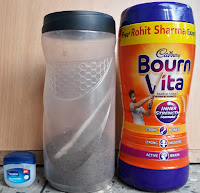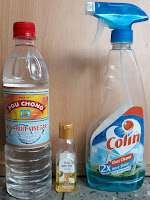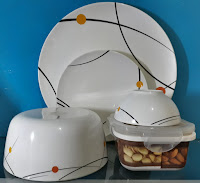SYNTHETIC FIBRES AND PLASTICS Chapter 3 Class VIII (C.B.S.E.)
Key Learning Points– Introduction, Synthetic fibres, Polymers, Characteristics of Synthetic fibres, Types of synthetic fibres and their uses, Plastic, Types of plastics- thermoplastics and thermosetting plastics, Characteristics of synthetic fibres or plastic, Plastic and environment.
 |
| Plastics Articles |
INTRODUCTION-The thin thread which is made up of natural or synthetic substance is called fibre. The natural fibres are obtained from plants and animals. e.g. Silk, cotton, wool, Jute etc. Natural fibres are limited in production as well as costly. Synthetic fibres are prepared in factories as an alternative of natural fibres and other reasons. They are durable i.e. last longer, cost-effective, and comparatively better in quality than natural fibres. e.g.- Rayon, Nylon, Acrylic, polyester, P.E.T., Terylene etc.
SYNTHETIC FIBRES– Those fibres which are made by chemical process using chemical substances are called synthetic or artificial or man-made materials. The synthetic fibres are prepared from petrochemicals. Synthetic fibres are made up of polymers. Polymers (Gr. Poly= many + mer =part/unit) are long chains of monomers. The synthetic fibres are made up of numerous polymers. Monomers are like units that combine together to form a polymer.
POLYMERS (Gr. Poly= many + mer =part/unit)-Polymers are long chain of repeating units called monomers. Numerous polymer chains form any particular substances. The monomers are changed into polymers by polymerization process. If we take the example of a necklace, the beads represent the monomers and the necklace represents the polymer. e.g.-‘Ester’ monomers form the ‘Polyester’ fibers. The cotton fibres are made up of ‘cellulose’ polymer. Cellulose polymer is made up of ‘glucose’ monomers.
Polymers are- light in weight, strong, durable, can be moulded into different shapes and cost-effective.
TYPES OF SYNTHETIC FIBRES-The main examples of synthetic fibres are-
1. RAYON (or ARTIFICIAL SILK)- Natural silk is very costly and difficult to produce from cocoons. Towards the end of nineteenth century, a synthetic fibre was prepared from ‘wood pulp’. It was called ‘viscose’ and in 1924 named ‘rayon’. The wood is made up of cellulose (a complex carbohydrate). The rayon is prepared from cellulose units by decomposition and regeneration. So, the rayon is a regenerated fibre.
It is cheaper than natural silk, absorbs moisture and sweat and therefore is comfortable to wear clothes made up of rayon. Rayon shines like silk and can be dyed in different colours.
Uses of Rayon-
1. Rayon can be easily woven like silk fibres. Different coloured clothes can be made.
2. Rayon is used to make suit, sarees, blouse, tie, jacket etc.
3. Rayon is mixed with cotton to make bed sheets.
4. Rayon is mixed with wool to make carpets.
2. NYLON– Nylon is the first fully synthetic material made in 1931. It was prepared from coal, water and air. None of the material used in its preparation was of plants or animal origin. The name ‘NYLON’ was coined based on the name of two cities NEW YORK (NY) AND LONDON (LON).
Nylon fibres are strong, elastic and light in weight. It has luster and can be easily washed. It is stronger than silk, wool, cotton and steel wire. These properties make nylon especial to make different articles. Nylon ropes are so strong and light weight that they are used in rock climbing.
Uses of Nylon-
1. Nylon is used to make clothes like socks, sportswear, hosiery garments, curtains etc.
2. Nylon is used to prepare ropes, toothbrush, tents, sleeping bags, car seat belts etc.
3. Nylon is used to make parachutes.
3. POLYERTSER-This synthetic fibre is made up of ‘ester’ monomers. Esters have sweet smell like fruits. It is a very fine material for preparing clothes because it does not wrinkle, easy to wash and dries quickly. Terylene, Tyrolean, Dacron and P.E.T. are well known polyester. It can be mixed with cotton fibres to form polycot, mixed with wool to form polywool; terylene is mixed with cotton to form terrycot etc.
Polyester + Cotton = Polycot
Polyester + Wool = Polywool
Terylene + Cotton = Terrycot
P.E.T. (Polyethene Tetraphthalate) is prepared by polymerization of ethane tetraphthalate. It is used to make, shirts, magnetic tapes for audio and video cassette recorders and bottles for drinking water, cold drinks, oils etc.
Uses of Polyester-
1. Shirts, pants and other dressing materials are prepared from polyester particularly by mixing with cotton and wool.
2. Polyester is used to prepare insulating materials, upholstery paddings, cushions, bed sheets, conveyor belts etc.
3. P.E.T. is used to make utensils, bottles, films, wires etc.
4. ACRYLIC– This synthetic fibre is prepared by polymerization of acrylonitritemolecules. It is very soft and light as like wool. It hardly weathers.
Uses of Acrylic-
1. Acrylic is used to make sweaters and shawls.
2. Acrylic is used to make very light and warm woolen blankets.
5. PLASTIC-Plastics are synthetic polymers which can be drawn into fibre and moulded into different shapes. Plastic are normally non-expandable. Plastics are used in various ways because of property of being remoulded. There is hardly any field where plastic is not used. E.g. Polythene, PVC (Polyvinyl Chloride), Melamine, Bakelite etc.
There are two types of plastics- (a) Thermoplastics
(b) Thermosetting plastics
(a) Thermoplastics– Those plastics which get deformed easily on heating and can be bent easily are called thermoplastics. e.g. Polythene, PVC (Polyvinyl Chloride), Polystyrene, Polypropylene, Teflon etc. Teflon is used to make nonstick cook wares. They can be recycled. They become soft on heating and hard on cooling, therefore, can be remolded again.
 |
| Polypropylene (PP) containers |
 |
| PET Containers |
Polythene and PVC are used in making of toys, combs, wires and different types of containers.
 |
| HDPE Containers |
(b) Thermosetting Plastics– Those plastics which when moulded once, cannot be softened and remoulded by heating easily. e. g. Melamine, Bakelite etc. They cannot be recycled. They often break on applying force. They are good insulators of heat and current. The articles made up of thermoplastics maintain their shape on very high temperatures.
Bakelite is used to prepare electric switches, handles of different utensils etc. Melamine resists fire and comparatively better in heat tolerance. It is used to prepare kitchen wares (crockery), microwave oven suitable containers, fire resistant clothes, floor tiles etc.
 |
| Switch of Bakelite |
 |
| Melamine Utensils |
CHARACTERISTICS OF SYNTHETIC FIBRES OR PLASTIC-Synthetic fibre are light in weight, cost-effective, available in different colours, easy to handle and clean, do not react with chemicals and acids, last longer, poor conductors of heat and electricity and free from bacterial actions.
The disadvantage of synthetic fibres is that they melt on heating. Synthetic clothes catch fire easily, melts and stick to the body of person wearing it. Therefore, utmost precautions must be taken while wearing synthetic clothes in the kitchen and laboratory.
PLASTIC AND ENVIRONMENT– Plastics are extensively used in packing industry. There excessive use also generates lots of plastic garbage. There is a challenge in disposal of plastic wastes. Plastics are not eco-friendly. Many plastics release carcinogenic chemicals in hot food kept in them. Medical wastes contain a number of plastic products. They are usually thrown in open or burnt in incinerators that cause air pollution. They choke the drainage pipes.
Those materials which decompose naturally by bacteria and fungi are called biodegradable materials. e.g. food waste, peels of fruits, paper, wood, cotton clothes, woolen clothes etc. Those materials which do not decompose naturally are called non-biodegradable materials. e. g.-Plastic wastes, metals objects etc. plastic products take several years to decompose. Burning of plastic wastes cause air pollution. Therefore, we should use biodegradable things as much as can be. The use of cotton and jute bags is one such major as both are biodegradable. Thermoplastics can be recycled but thermosetting plastics cause major problem of disposal. As a responsible citizen we should follow the principles of 4R- reduce, reuse, Recycle and Recover.
CHECK YOUR PROGRESS TIME- 40 MINUTES MARKS- 4 x 5=20
Q.1 What is synthetic fibre? Write characteristics of synthetic fibres.
Q.2 Write short notes on – Rayon and Nylon.
Q.3 What is plastic? Differentiate between thermoplastic and thermosetting plastic.
Q.4 Why plastics are favored for storing the food items like pickle?
GROUP PROJECT-
Collect different kinds of plastics and prepare a detail of each type of plastic.
SOLVED EXERCISE QUESTIONS
Q.1 Explain why some fibres are called synthetic.
Ans- There are some fibres which are not found naturally. They are prepared by humans by chemical processes. That is why they are called synthetic or man- made fibres. e.g. – Nylon, Polyester, Acrylic, Plastic, etc.
Q.2 Mark the correct answer:
Rayon is different from synthetic fibres because
(a) it has a silk like appearance
(b) it is obtained from wood pulp
(c) its fibres can also be woven like those of natural fibres.
Ans- (b)
Q.3 Fill in the blanks with appropriate words:
(a) Synthetic fibres are also called ……………… or ……………… fibres.
(b) Synthetic fibres are synthesized from raw material called …………………….
(c) Like synthetic fibres, plastic is also a ………………..
Ans-(a) artificial , man-made (b) petrochemicals (c) polymers
Q.4 Give two examples which indicate that nylon fibres are very strong.
Ans-Nylon is very strong synthetic fibres. They are used in preparing climbing ropes, parachutes, tents, tooth brush etc. These examples show the toughness of nylon because of which they last longer.
Q.5 Explain why plastic containers are favoured for storing food.
Ans- Plastic containers are light in weight, durable, cost-effective, easy to handle and clean. Plastic containers do not have the effect of chemicals, food items kept in them and bacterial action is negligible. These features make plastic a favoured choice for storing food items.
Q.6 Explain the difference between the thermoplastic and thermosetting plastics. Ans-
|
S.N. |
Thermoplastic Plastics |
Thermosetting Plastics |
|
1 |
They get softened and deformed on heating. |
They do not become soft and retain the shape on heating. |
|
2 |
They become soft on heating and hard on cooling. |
They maintain the shape on heating. |
|
3 |
They can be remoulded and recycled |
On break on applying force and cannot be recycled. |
Q.7 Explain why the following are made of thermosetting plastics:
(a) Saucepan handles (b) Electric plugs/ switches/ plug boards
Ans-(a) Saucepan handles are made up of thermosetting plastics because on heating their shape does not change. Thermosetting plastics are also poor conductors of heat.
(b) Electric plugs/ switches/ plug boards are made up of thermosetting plastics like Bakelite and melamine because they are poor conductors (or insulators) of heat.
Q.8Categorise the materials of the following products into ‘can be recycled’ and ‘cannot be recycled’:
Telephone instruments, plastic toys, cooker handles, carry bags, ball point pens, plastic bowls, plastic covering on electric wires, plastic chairs, electric switches
Ans-
|
Can be recycled |
Cannot be recycled |
|
Plastic toys |
Telephone instruments |
|
Carry bags |
Cooker handles |
|
Ball point pens |
Electric switches |
|
Plastic bowls |
|
|
Plastic covering on electric wires |
|
|
Plastic chairs |
|
Q.9 Rana wants to buy shirts for summer. Should he buy cotton shirts or shirts made from synthetic materials? Advise Rana, giving your reason.
Ans- Cotton clothes are good absorbent of sweat coming out of body. The absorbed sweat is exposed on outer layers of cotton clothes and start evaporating. So, the cooling is caused. This is the reason Rana should buy the cotton shirts for summer.
Q.10 Give examples to show that plastics are non-corrosive in nature.
Ans- Plastics hardly react with any chemical substance; therefore, they do not corrode easily. e. g.- Teflon is a plastic which is used to prepare non-stick coating on cooking pans and other utensils. e. g- Plastic containers are used to store many chemicals in laboratories.
Q.11 Should the handle and bristles of a toothbrush be made of the same material? Explain your answer.
Ans- No, handle of toothbrush should be hard and flexible to withstand the stress applied by the person. Whereas, the bristles of the toothbrush should be made of soft, flexible and long-lasting synthetic fibres so that the gums and teeth do not get damaged as well as last longer.
Q.12‘Avoid plastics as far as possible’. Comment on this advice.
Ans- Plastic is a non-biodegradable material. The used plastic products get accumulated in environment and cause several environment problems. Their disposal is a big challenge. On burning they produce harmful smokes and therefore cause air pollution.
When food items thrown in plastic carry bags are often eaten by stray animals and birds. Thus many health hazards are caused due to plastic in such animals. The polythene bags clog the drainage systems and cause many problems. These are some reasons due to which we should avoid plastic as far as possible.
Q.13 Match the terms of column I correctly with the phrases given in column II.
Ans- Column I Column II
(i) Polyester (a) Prepared by using wood pulp
(ii) Teflon (b) Used for making parachutes and stockings
(iii) Rayon (c) Used to make non-stick cookwares
(iv) Nylon (d) Fabrics do not wrinkle easily
Ans- (i) –d (ii)-c (iii)-a (iv)- b
Q.14 ‘Manufacturing synthetic fibres is actually helping conservation of forests’. Comment.
Answer- Natural fibres are obtained from plants and animals. In a forest, plants and animals are interdependent upon each other. The natural fibres are generally obtained by cutting the plants and killing of animals. On the other hand synthetic fibres are prepared from petrochemicals. Therefore, manufacturing of synthetic fibres is in fact helps in conservation of forests.
Q.15 Describe an activity to show that thermoplastic is a poor conductor of electricity.
 |
| Plastic as an insulator |

0, which increases the difference between the two arms, is statistically significant P 0 cialis 20mg price There are also other harmful substances such as benzene, a toxic substance found in vehicle fumes, and heavy metals
Wowww sir, Excellent work